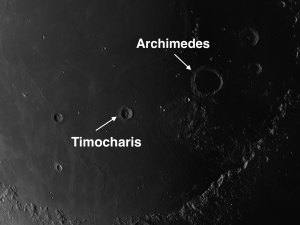The week of March 20-26 takes us from Lunar Day 22 to Day 28, so the Moon is viewable only in the early morning hours. This week we will highlight the crater Timocharis in Mare Imbrium.
Timocharis: [NW/G8] About three crater-diameters to the southwest of Archimedes is Timocharis, a complex crater that stands conspicuously isolated in the Imbrium Sea. It is 21 miles in diameter, 2 miles deep, and has a number of complexities that include a sharp rim, terraced walls, and an ejecta blanket. At one time in its past, Timocharis received a dead-center meteor impact that totally obliterated its central mountain!
OF ADDITIONAL INTEREST IN SPACE FROM LUNAR DAY 22-28:
Throughout the week Comet 41P/Tuttle will be visible in the evening at magnitude +7.3, an easy binocular target. On Tuesday evening as soon as it gets dark, look for it just 1 ½° SE of Merak, the southernmost of the two pointer stars in the Big Dipper. During the rest of the week, the comet will traverse the bowl of the Big Dipper.
The vernal equinox, announcing the beginning of spring, occurs at 6:29 AM on Monday morning. On this date, the length of day and night are approximately equal (hence the term equinox, equal night), and Arcturus, the “Spring Star”, appears over the ENE horizon at the beginning of nautical twilight.
======================
It is highly recommended that you get a copy of Sky and Telescope’s Field Map of the Moon, the very finest Moon map available for use at the telescope. It is available for $10.95 at www.skyandtelescope.com and on Amazon. All features mentioned in this blog will be keyed to the grid on the Field Map and will look like this: Plato: [NW/D9]
Credits:
Courtesy of Gray Photography of Corpus Christi, Texas
Lunar photos: NASA / USGS / BMDO / LROC / ASU / DLR / LOLA / Moon Globe. Used by permission
- Rupes Cauchy: A Best Known Fault on the Moon - July 22, 2024
- Moon Crater Schickard – Crater Floor has Stripes - July 15, 2024
- Moon Craters Langrenus and Vandelinus - July 8, 2024

